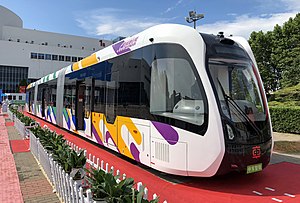This article has multiple issues. Please help improve it or discuss these issues on the talk page. (Learn how and when to remove these messages)
|
| Autonomous Rapid Transit (ART) 智能轨道快运系统 (智轨)[1] | |
|---|---|
 | |
 | |
| Manufacturer | CRRC |
| Family name | Guided bi-articulated bus |
| Constructed | 2017 |
| Entered service | Inauguration date: 2018[2][3] |
| Specifications | |
| Car body construction | Space frame with bolted-on panels |
| Train length | 3 carriages: 31.64 m (103 ft 9+5⁄8 in) |
| Width | 2.65 m (8 ft 8+3⁄8 in)[4] |
| Height | 3.4 m (11 ft 1+7⁄8 in)[4] |
| Low-floor | Yes |
| Maximum speed | 70 km/h (43 mph)[5] |
| Power supply | 600 kWh Lithium–titanate batteries[6] |
| Electric system(s) | 10 kV |
| Wheels driven | Rubber wheels on a plastic core[7] |
| Bogies | Multi-axle steering system,[6] Active suspension |
| Minimum turning radius | 15 m (49.2 ft) |
| Track gauge | N/A |
| Passengers |
|
|---|---|
| Max. distance at full charge | 40 km (25 miles) (standard model)[2] 80 km (50 miles) (UAE model) |
| Charging time | |
| Min. width of lane | 3.5 m (11.5 ft)[10] |
| Life expectancy | 25+ years for body structure |
Autonomous Rail Rapid Transit (ART) is a lidar (light detection and ranging) guided bus and bi-articulated bus system for urban passenger transport. Developed and manufactured by CRRC through CRRC Zhuzhou Institute Co Ltd, it was unveiled in Zhuzhou in the Hunan province on June 2, 2017.[2][3][11] ART is specifically referred to as a train or rapid transit as Digital-rail Rapid Transit by its manufacturer, however the public describes it as a bus. Its exterior is composed of individual fixed sections joined by articulated gangways, resembling a rubber-tyred tram and translohr.
The system is labelled as "autonomous" in English, however, the models in operation are optically guided and feature a driver on board.[12] Despite "rail" in the name, the system does not use rails.
Automated Rapid Transit systems (ARTs) can operate independently without the need for a guiding sensor and as a result, they fall under the classification of buses. Consequently, vehicles deployed on these routes are mandated to display license plates.
- ^ "宜宾:全球首条智能轨道快运系统运营线开通". 2019-12-05.
- ^ a b c Cite error: The named reference
CRRCwas invoked but never defined (see the help page). - ^ a b Xiang Bo: Chinese rail maker develops smart bus. Xinhua, 2 June 2017 20:26. Downloaded on 4. August 2017.
- ^ a b Cite error: The named reference
NCTVwas invoked but never defined (see the help page). - ^ Newman, Peter (September 25, 2018). "Why Trackless Trams Are Ready to Replace Light Rail". The Conversation US. Archived from the original on May 12, 2019. Retrieved July 15, 2019.
- ^ a b Cite error: The named reference
Rastogiwas invoked but never defined (see the help page). - ^ a b Amazing World: Track-less train : The transit system uses rubber wheels on a plastic core : Trains without track. 3 June 2017. Downloaded on 22 July 2017.
- ^ Cite error: The named reference
CCTVwas invoked but never defined (see the help page). - ^ Quick charge! Supercapacitor tram unveiled in China. New China TV, 2 June 2017. Downloaded on 22 July 2017.
- ^ Cite error: The named reference
Kenwas invoked but never defined (see the help page). - ^ Spiegel TV.
- ^ Chamberlain, Lisa (2020-12-23). "Trackless trams may be the best alternative to light rail". City Monitor. Retrieved 2022-11-04.